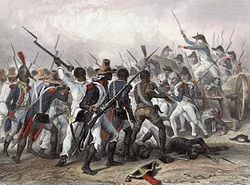Pointe Coupée Slave Conspiracy of 1795
| Part of a series on |
| North American slave revolts |
|---|
 Attack and capture of the Crête-à-Pierrot (Combat et prise de la Crête-à-Pierrot, March 1802) in the Haitian Revolution by Auguste Raffet, engraving by Ernest Hébert |
| Context
|
| Before 1700 (Spanish Florida, victorious)
(Real Audiencia of Panama, New Spain, suppressed)
(Veracruz, New Spain, victorious)
(New Spain, suppressed)
(New Spain, suppressed)
|
| 18th century (British Province of New York, suppressed)
(British Jamaica, victorious)
(British Chesapeake Colonies, suppressed)
(Louisiana, New France, suppressed) (Danish Saint John, suppressed)
(British Province of South Carolina, suppressed)
(British Province of New York, suppressed)
(British Jamaica, suppressed) (British Montserrat, suppressed)
(British Bahamas, suppressed)
(Louisiana, New Spain, suppressed)
(Louisiana, New Spain, suppressed) (Dutch Curaçao, suppressed)
|
| 19th century
(Virginia, suppressed)
(St. Simons Island, Georgia, victorious)
(Virginia, suppressed) (Territory of Orleans, suppressed)
(Spanish Cuba, suppressed)
(Virginia, suppressed)
(British Barbados, suppressed)
(South Carolina, suppressed)
(Cuba, suppressed) (Virginia, suppressed)
(British Jamaica, suppressed)
(off the Cuban coast, victorious)
(off the Southern U.S. coast, victorious) (Indian Territory, suppressed)
(Spanish Cuba, suppressed)
|
| Notable leaders |
|
The Pointe Coupée Slave Conspiracy of 1795 was an attempted slave rebellion which took place in Spanish Louisiana in 1795. It has attracted a lot of attention and been the subject of much historical research.[1] It was preceded by the Pointe Coupée Slave Conspiracy of 1791.
Trial
On May 4, 1795, 57 enslaved people and three local white men were put on trial in modern day Pointe Coupée Parish after an attempted slave conspiracy in the vicinity of the Pointe Coupee military post. Planters found a copy of Victor de Mirabeau (Mirabeau the Elder)'s Théorie de l'Impôt, which included the Declaration of the Rights of Man and of the Citizen of 1789, in one cabin.[2] The trial ended with 23 of the enslaved people being hanged, their corpses decapitated, and their heads posted along the road. 31 more were sentenced to flogging and hard labor. All three white men were deported with two sentenced to six years forced labor in Havana.[3]
See also
References
- ^ Hall, Gwendolyn Midlo (1992). "The 1795 Slave Conspiracy in Pointe Coupée: Impact of the French Revolution". Proceedings of the Meeting of the French Colonial Historical Society. 15. Michigan State University Press: 130–141.
- ^ Rasmussen, Daniel (2011). American Uprising: The Untold Story of America's Largest Slave Revolt. Harper Collins. p. 89.
- ^ Hall, Gwendolyn Midlo (1992). Africans in Colonial Louisiana. Louisiana State University Press. p. 344. ISBN 9780807116869.
- ^ "1795 Louisiana Slave Conspiracies - University of California, Berkeley".










